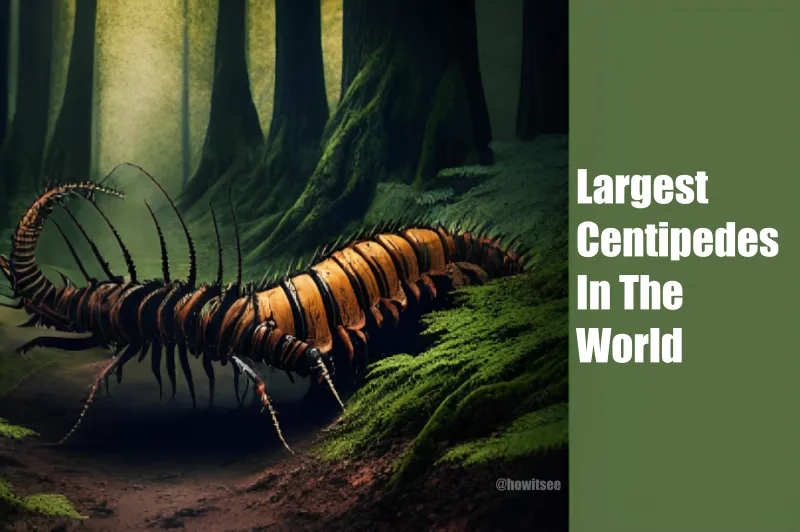Centipedes continue to be seen as fear-evoking creatures among humans. These creepy crawling creatures, with their long legs and antennas coupled with their vibrant body coloration, are an essential aspect of study for biologists.
Centipedes have been used since time memorial in traditional medicines and even in modern treatments where their venom is used in cancer drug development. Centipedes come in various sizes and colors, which raises a standard question, Which are the largest centipedes in the world?
Among the five centipede families, the Scolopendridae family houses the largest centipedes. In today’s article, we are going to present before you a vivid list of the Top 10 Largest Centipedes in the world.
Top 10 Largest Centipedes in the World
10) Mediterranean Banded Centipede
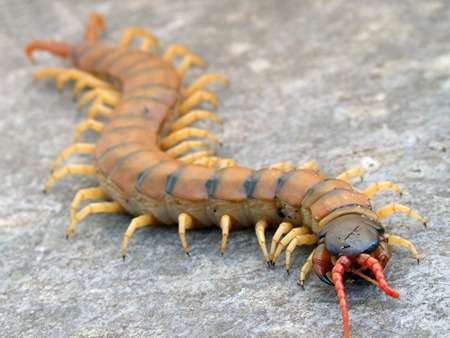
- Genus- Scolopendra
- Scientific name- Scolopendra cingulata
- Location- Mediterranean region
With an average length of 10-15 cm (4-6 in), the Mediterranean banded centipede is one of the smallest species in the Scolopendridae family.
However, it is pretty significant in comparison to centipedes from another family. Their body has a golden yellow hue, segmented by dark stripes. It is a carnivorous species and will feed on any animal whose size is smaller than itself, like invertebrates, lizards, etc.
9) Tanzanian Blue Ring Leg
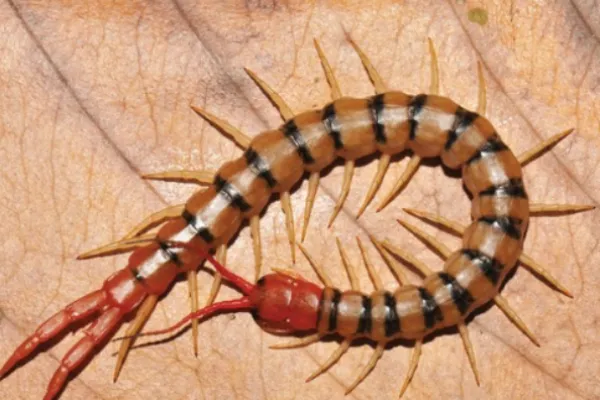
- Genus- Scolopendra
- Scientific name- Scolopendra mortisans
- Location- Worldwide distribution, found in almost all continents (except Antarctica)
Next up in our list of Largest Centipedes on the planet we have the Red-headed centipede. These species grow up to a length of 12-13 cm (5.6 in) and can be easily recognized from their bright-colored head and striped segments.
The body coloration may differ depending upon their location. The Tanzanian blur ring legs are carnivorous species and use neurotoxins to immobilize their prey.
8) Banded Desert Centipede
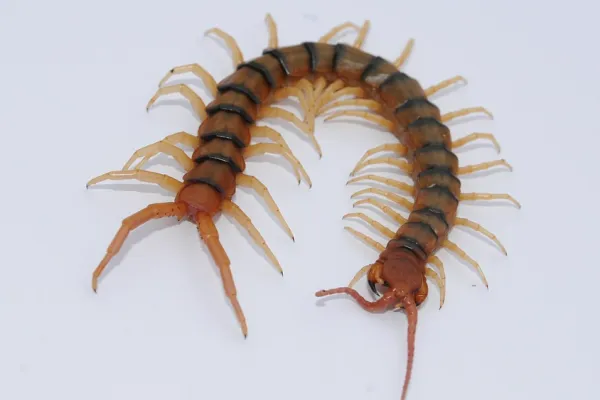
- Genus- Scolopendra
- Scientific name- Scolopendra polymorpha
- Location- the Southwestern United States and Mexico
Better known as the common desert centipede, one can easily recognize them by their body coloration.
They have brown-colored heads, yellow appendages, and yellowish-orange or light brown bodies, with segments marked by black lateral stripes, hence giving them the name “tiger centipede.”
These centipedes have an average body length of 12-18 cm (5-7 in); they are found in burrows or decaying pieces of logs.
7) Indian Tiger Centipede
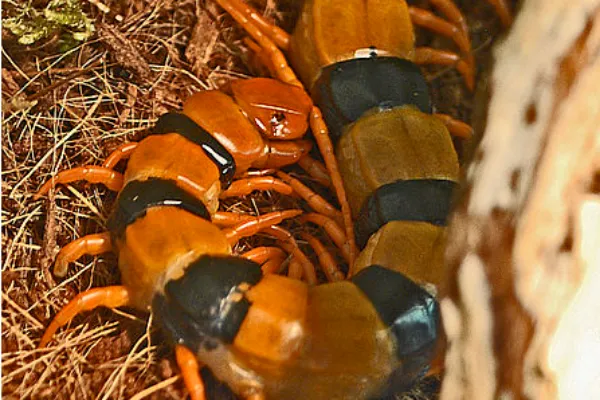
- Genus- Scolopendra
- Scientific name- Scolopendra Hardwicke
- Location- Southern India
This species of centipedes is widespread for its bright contrasting coloration. The body is dark orange and is segmented by dark black bands and orange-colored appendages.
They reach up to a length of 6.3 inches (16 cm) which is quite huge and possess venom that causes swelling and sleepiness.
6) Texas Readheaded Centipede
- Genus- Scolopendra
- Scientific name- Scolopendra heros
- Location- the Southwestern United States and Northern Mexico
Bearing an average body length of 6.5- 7 in (15-17 cm), it is one of the most enormous centipedes in the world. They possess a bright red-colored head, thereby getting the name “redhead.”
However, the body coloration and has yellow-colored legs differ from place to place. Texas redheads are nocturnal predators, and they feed on smaller mammals, frogs, small size invertebrates, etc., and use venom to incapacitate their prey.
5) Scolopendra viridicornis
- Genus- Scolopendra
- Scientific name– Scolopendra viridicornis
- Location- Amazon Rainforests, especially in Brazil
With an alarming length of 6.5 – 7.5 in, this giant species of centipede is undoubtedly one of the largest centipedes on the planet.
Their bodies are reddish-brown, with black lateral stripes and yellow legs. These centipedes are carnivorous and feed on small lizards, mice, and even bats.
4) Scolopendra cataracta
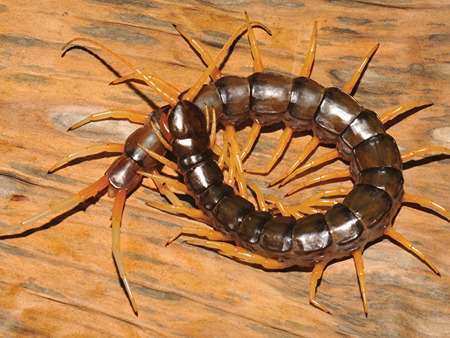
- Genus- Scolopendra
- Scientific name– Scolopendra cataracta
- Location- Southeast Asian countries like Thailand, Vietnam, etc.
These centipedes are one of the largest centipedes on the planet, belonging to the family Scolopendridae. They grow up to gigantic sizes of 19- 22 cm (8 inches) in length, with long yellow color appendages.
The cataracta species of centipedes are amphibious (the only known centipede to do so). They are equipped with a greenish-black colored hydrophobic body surface.
3) Haitian Giant Centipede
- Genus- Scolopendra
- Scientific name- Scolopendra alterans
- Location- Caribbean Islands like the Bahamas
The Haitian Giant centipede is one of the largest terrestrial predators in the Caribbean, with an alarming length of nearly 8 in. The body coloration is orange, segmented by black stripes and yellow legs.
They feed on invertebrates like spiders, small reptiles, amphibians, etc. They are venomous and have quite a painful bite, causing swelling around the bitten area.
2) Chinese Redheaded
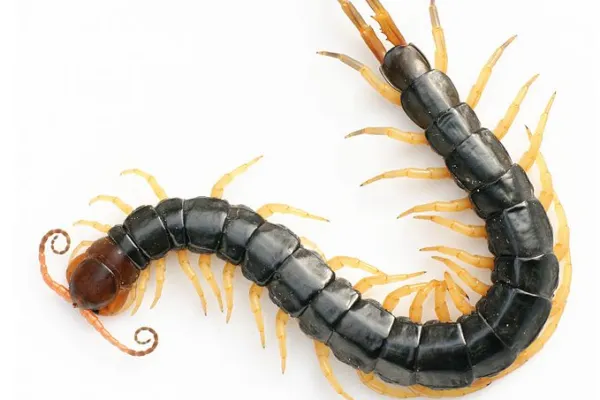
- Genus- Scolopendra
- Scientific name- Scolopendra subspinipes
- Location- Eastern Asia
Known by various names like the Chinese redheaded, jungle centipede, and Hawaiian centipede, these centipedes are one of the largest or probably the second-largest centipedes on the planet.
They grow up to a length of 20 cm (8 in), with one specimen measuring as long as 37 cm. Occurring in several colors due to their wide geographic distribution, the Chinese read-heads are quite aggressive predators.
Owing to their large size, they feed on small reptiles, amphibians, mice, and almost any animal smaller than themselves.
1) Amazonian Giant Centipede
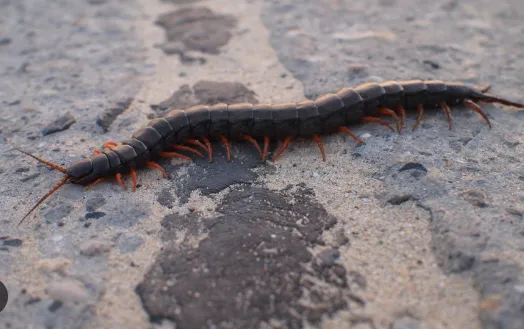
- Genus- Scolopendra
- Scientific name- Scolopendra Gigantea
- Location- South American and Caribbean rainforests
In the first position, we have the largest centipede on the planet, Scolopendra Gigantea. Popularly known as the Amazonian Giant Centipede or the Peruvian Giant yellow-leg centipede, these species grow up to an enormous length of 30 cm (12 in).
The body has a characteristic dark brown coloration. The legs are orange or yellowish colored and have alternating dark bands. Their diet consists of a wide variety of organisms, starting from small lizards and reptiles like snakes to frogs, tarantulas, and other invertebrates. They have often been spotted feeding on small birds and bats.
In conclusion, the world of centipedes is home to some of the most fascinating and awe-inspiring creatures on the planet.
From the massive Scolopendra gigantea to the elusive and venomous Cryptops hortensis, these largest centipedes captivate our imaginations and challenge our perceptions of the natural world.
While their size and predatory prowess may evoke a sense of fear, these creatures play vital roles in their ecosystems, controlling insect populations and contributing to the delicate balance of nature.
Here, we end our article on the Top 10 Largest Centipedes in the world. We will be bringing more informative articles. Until then, goodbye, and stay tuned.
Also Read:

Meet Abhidept (nickname Monty), the visionary founder of How It See, being an engineering student, he’s fueled by an insatiable curiosity about the world around him. He is captivated by an eclectic correlation between animal groups, science, and nature, and this fascination drives his quest for understanding.
After completing his degree, he’s set on a mission to delve deep into the realm of nature, accumulating knowledge to share with you through his writing. In the meantime, he loves to watch anime and read anime.
